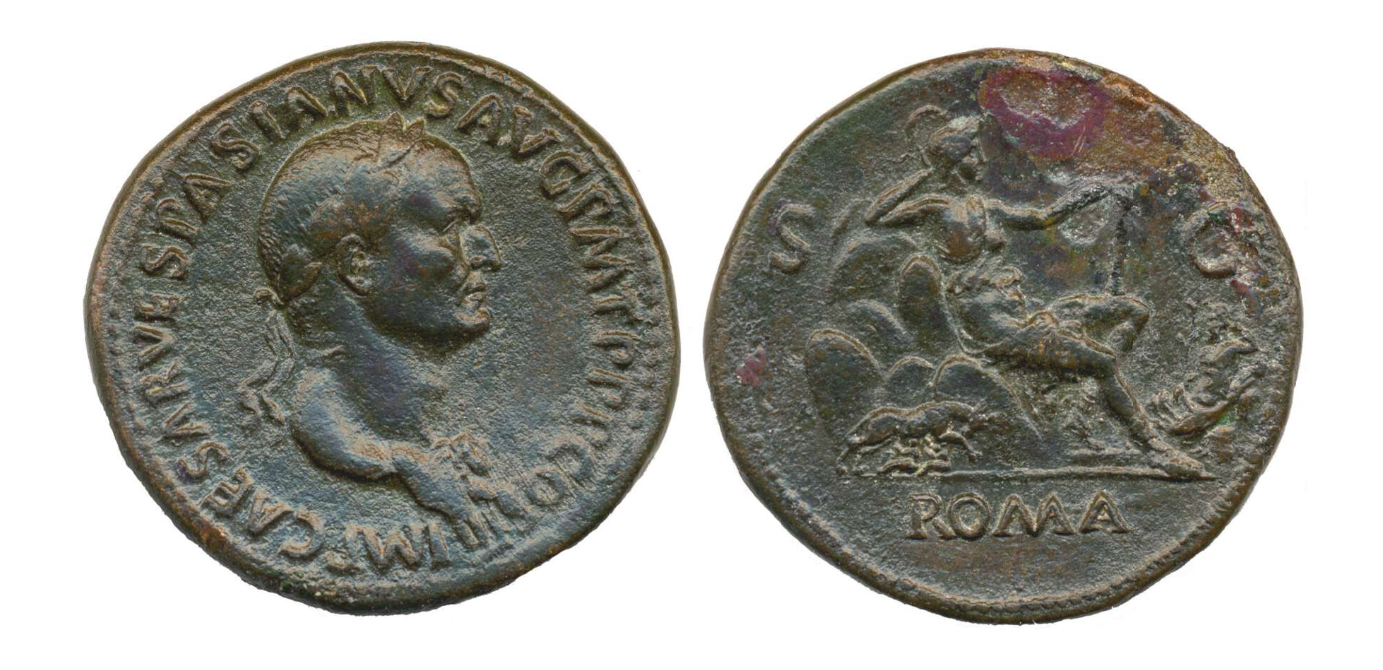The Harlot in Revelation: A mocking of the Roman Empire
The story of the harlot Babel in the book of Revelation in the Bible is one of the most complex stories and uses a lot of subtle irony about the Roman Empire. Ready for this?
The coin
Let us take a look at a popular coin that was available around this time.

On the obverse you can see Emperor Vespasian (reigned from 69 to 79) and the inscription “Imp Ceasar Vespasianus Aug PM TP PP COS III” which means “Emperor Ceasar Vespasian Augustus Pontifex Maximus (Greatest Priest), Tribunicia Potestas (Tribunal Power), Pater Patriae (Father of the Fatherland), Consul for the third time” which is a praise of the power and achievement of the emperor.
On the reverse side is the goddess Roma in military dress, sitting on the seven hills of Rome. She has a small sword on her knee, symbolizing the military power of Rome. To the left and right of her is SC (Senatus Consultum = by decree of the Senate).
On the right side you see the male representation of the river Tiber (surrounding Rome) bowing to Roma. On the lower left you can see a small female wolf nursing Remus and Romulus (describing the founding story of Rome, founded in 753 B.C. by the Ascendants of Troy). And finally, at the very bottom, Roma is written, perhaps in reference to the secret name of Rome: Amor, which means love.
So the reverse side of the coin praises the power and permanence of Rome.What does the text in Revelation say about this?
- When a woman is described as a wolf, it means that she is a prostitute (even in normal Latin), the secret name Amor makes it even worse.
- The goddess of Rome is described here as a harlot, not only that, but as the mother of all harlots.
- The hills of Rome represent the beast and the kings who will destroy Roma (the prostitute) — Roma is the victim of the city she protects.
- Roma does not protect herself from enemies with the sword, but she is covered with the blood of the saints.
The coin depicting the Pax Romana is transformed into an image of contempt and disgust, reminding every believer who sees it in everyday life that Rome cannot be trusted — a very effective counter-propaganda.
The Ekphrasis
The first half of chapter 17 is the only part of Revelation with an interpreting angel on a static picture (even in chapter 21 — the New Jerusalem — the angel only shows, does not explain, and there is action — the city comes down, water flows, trees bear fruit). In chapter 17 we have a very static picture. And the focus is on understanding the prostitute based on the beast.
And this text has the style of an ekphrasis, which is the mainly rhetorical description of an object of art (it could also be others like people, festivals, …). The first one was the description of the shield of Achilles in the Ilias (Battle of Troy).
This type of literature was very popular in Rome from the first century BC. The main element is the bewildered narrator, because the point of it was to either to have a deeper understanding of the picture or to see the deeper/hidden meaning of the picture which is sometimes hard to decipher like the “Tabula of Cebes” which was probably the most popular ekphrasis.
This tabula may also be a basis for Revelation 17. It describes a group of people who see a picture on a dedication plaque in a temple that they don’t understand. An old man comes and explains it to them (see chapter 8):
- Life is represented by three rings separated by walls.
- The goal is to get into the middle ring, which is a kind of Garden of Eden that can only be reached after overcoming distractions (wealth, indulgence, …) and following virtues (temperance, fortitude, …).
- There is a great crowd that wants to enter.
- At the first gate there is a woman offering a cup to everyone, her name: deception, the drink: error and lack of knowledge.
Another parallel to Revelation 17 could be the Ode of Salomon 38/9–14, where error and lack of knowledge imitate the bride and groom. The wine at this wedding made the people vomit their understanding.
So the point of the ekphrasis is to show thatUnderstanding this deception is the first step toward God’s kingdom.If you are deceived by Rome, there is little hope for you.This deception is so great that it is hard to miss.